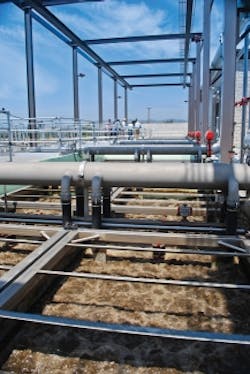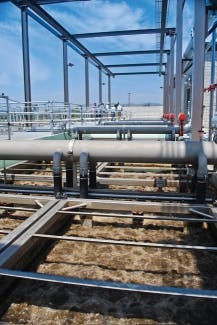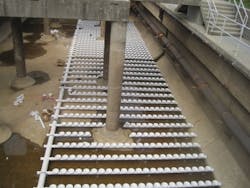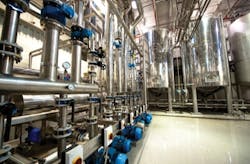Recycling Facility Benefits from Energy Efficient Processes
In the current environment of rising energy costs, municipalities are under pressure to reduce power consumption while continuing to maintain the quality and efficiency of public infrastructure. The City of Santa Paula, CA, faced this challenge when it became necessary to replace its noncompliant wastewater treatment facility.
As a result of an investment in energy-efficient technology, the city's new facility power consumption costs for the first five months of operation were more than 35 percent lower than expected.
Santa Paula is located in Ventura County and has a population of approximately 30,000. Its original wastewater treatment facility was built in 1939 and had accrued more than $8 million dollars in compliance related fines. The Regional Board agreed that if the city could come into compliance by a certain date, they would waive the fines.
Although originally choosing the conventional design-bid-build approach, after years of work and funding engineering studies, the City Council and staff realized this method would not meet their tight timeline or budget requirements. In July 2007, the City Council approved the design-build-operate-finance (DBOF) method of procurement and in May 2008, the City Council awarded the DBOF contract to Santa Paula Water, LLC, a joint venture of PERC Water Corp. and Alinda Capital Partners.
PERC Water began project engineering on May 6, 2008, the day after the DBOF contract was signed, and commenced construction two months later. Construction was completed in December 2009 and on May 13, 2010, seven months in advance of its December 15 compliance deadline, the facility took full flow from the city.
Facility Design
PERC Water designed a 4.2 mgd membrane bioreactor (MBR) facility where the majority of the treatment occurs in underground tanks. The tanks require approximately three-quarters of an acre of land and are built mostly below the existing grade. The tanks use common wall construction, requiring a total volume of 7,000 cubic yards of concrete and less yard piping and conduits. The operations buildings are constructed above the tank structure, reducing land requirements, and contain the process equipment, a laboratory, administrative offices, etc. The covered tanks and noise and odor controls make the facility neighbor-friendly and a positive addition to the surrounding community.
The wastewater is treated to a tertiary level meeting Title 22 requirements and is currently discharged to 13 acres of percolation ponds located to the east of the new facility. However, the city is drafting an alternate use plan for the recycled water to reclaim and reuse it as an additional revenue stream.
Energy Efficiencies
The contract stipulated that PERC Water would operate the facility for 30 years. Because the company is responsible for the facility's long-term operations and maintenance, they designed and constructed the facility to control and minimize energy consumption costs and deliver the smallest environmental footprint possible.
PERC Water invested their own funds beyond the contract cost in design enhancements during construction to reduce energy consumption costs. It paid off - in the first five months of the facility's operation, power consumption costs were approximately 35 percent lower than expected. The energy savings are split 50/50 with the city.
Energy-efficient features included:
UV Disinfection - The facility uses the Degremont Technologies' Aquaray® 3X UV Modules which are equipped with amalgam lamps for UV disinfection. Amalgam lamps are the most energy efficient lamps for generating ultra violet light at the high power density required. Additionally, the control system can vary the lamp output to precisely meet the UV dose requirements for disinfection, minimizing the electrical consumption.
Membrane system - The MBR technology combines biological wastewater treatment and membrane filtration into one unit process, producing a consistently high quality effluent in an extremely compact footprint. PERC Water incorporated Koch Membrane Systems' single header PURON™ membrane filtration modules into the MBR design because they are energy efficient and provide significantly lower lifecycle costs.
Aeration system - As membrane scouring and aeration account for nearly half of a facility's power consumption, PERC Water selected energy-efficient air production and usage systems. Most noticeable are the facility's K-Turbo High Speed Turbine blowers which are used throughout the facility's various process areas. The blowers' internal variable frequency drives allow operators to control, monitor and specifically adjust the air flow for aeration over a wide range of operations.
Smart control system - The Supervisory Control and Data Acquisition (SCADA) system developed by PERC Water has the unique ability to gather, display, track and store live data generated by the facility. In an effort to optimize energy consumption, the system is designed to consistently update operators on the exact status and measurements of all of the facility's processes such as air flow, water flow and tank capacity and will notify operators of abnormal conditions directly to the operator's cell phone.
The SCADA system is accessed through Central PERC™, a web application where all the facility's current and historical operational data is integrated within one platform that can be accessed and controlled wirelessly from an iPad, iPhone, Droid or any other web-capable device.
Lighting design - Using a combination of natural lighting, LED lamps, electronic ballast for fluorescent lamps, light sensors and automatic dimming devices, the facility exceeded the state's Title 24 energy-efficiency requirements and Southern California Edison's stringent standard.
As a result of the energy saving measures employed at the facility, PERC Water was awarded the 2009 Sustainability and Resource Protection Award by the Environmental Business Journal and a grant through Southern California Edison's "Savings by Design" program to help fund the energy saving technology.
John Quinn, the city's Finance and Public Works Director, said, "The City of Santa Paula is enthusiastic about our new water recycling facility's reduced power costs as it means savings for our citizens over the long term."
Vice Mayor Gonzales likewise said, "The savings are significant for the City of Santa Paula. In the end, the benefactors are the rate payers."
"It is imperative that infrastructure become more sustainable and fiscally responsible," said Brian Cullen, President of PERC Water. "The technology available in today's market raises the standard for efficiency and the Santa Paula facility demonstrates that investing in these energy saving technologies results in savings to the ratepayers."
Dr. Shane Trussell, a leading expert in membrane bioreactors and PERC Water's lead advisor for the facility's process design, described the facility as "world-class." He said, "As a result of the team's equipment selection and robust design features, it is one of the most energy-efficient and cost-effective membrane bioreactor installations in the world."
WW
Learn more about this project at: www.percwater.com.
More WaterWorld Current Issue Articles
More WaterWorld Archives Issue Articles



